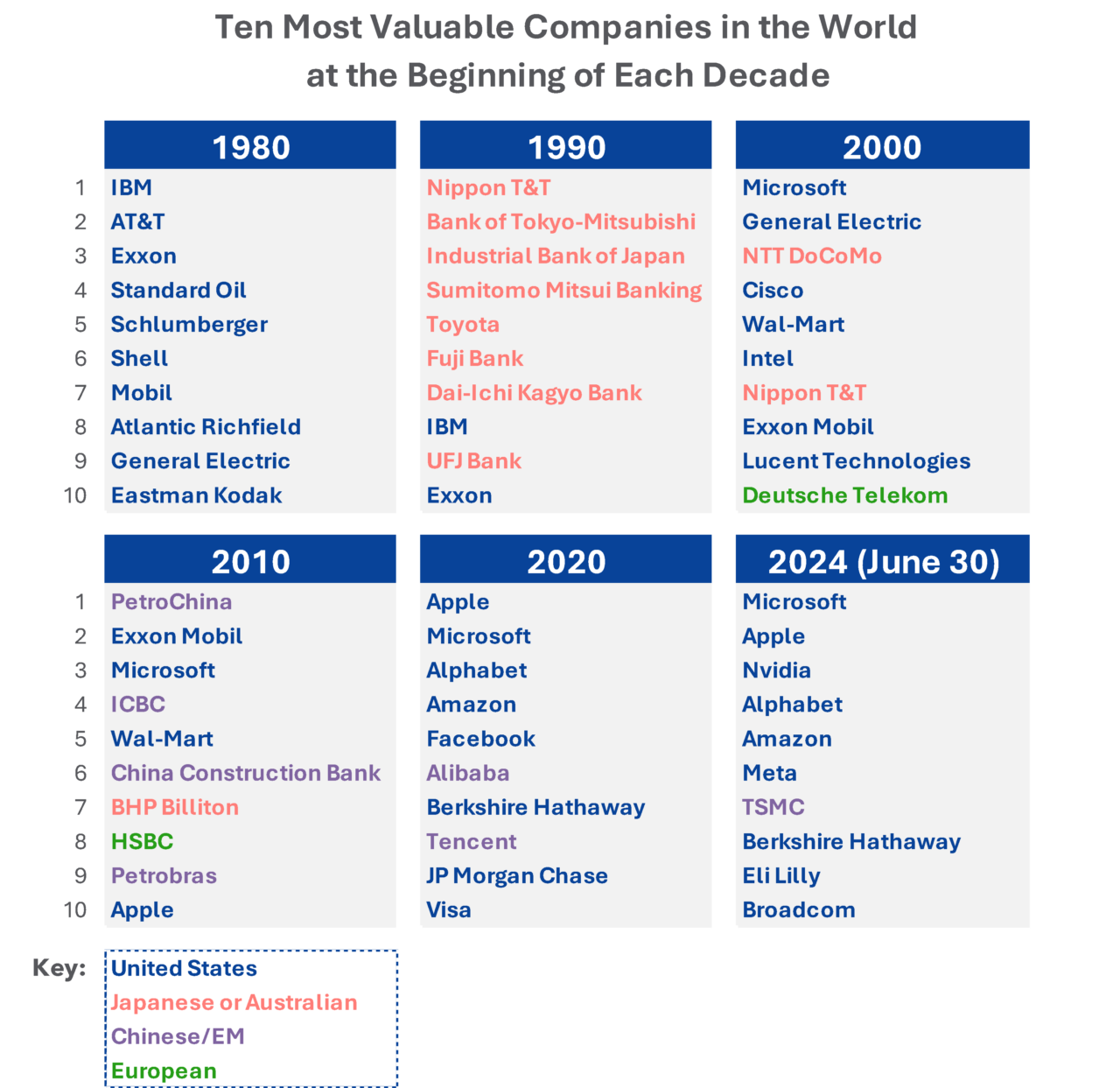Can you imagine Amazon not being the dominant player in online retail? Or Apple struggling to sell its products due to an upstart competitor? Or Microsoft, Netflix, or Google not being dominant in their market segments? Or tech companies underperforming the rest of the market for a long-term period? Given the dominance of big tech companies over the past decade-plus, it’s hard to imagine them not continuing along trend and delivering market-beating returns for their investors.
But history shows that the economy, markets, industries, and companies move in cycles. Trees don’t grow to the sky, and dominant companies in seemingly bulletproof industries don’t stay dominant and bulletproof. Examine the below chart that shows the ten most valuable companies in the world at the beginning of each decade and as of June 30, 2024.

Decade By Decade Overview
1980
In 1980, following the oil crisis of the 1970s, six of the ten most valuable companies were energy companies. The non-energy leaders, IBM, AT&T, GE, and Kodak, were dominant in their fields. The idea that Kodak would declare bankruptcy 32 years later or that IBM would shift industries due to competition was unthinkable.
1990
The 1980s saw the rise of Japanese companies. By 1990, eight of the top ten most valuable companies were Japanese. Japan seemed poised to take over the U.S. economy as the largest in the world.
Then, in the early 1990s, the trend of Japan’s rising dominance sharply reversed. Its economy overheated and sparked inflation. In response, the Japanese Central Bank raised and kept raising interest rates. High rates tanked their economy and stock market. Between its 1989 peak and early 2009, Japan’s stock market lost 80 percent of its value and has only regained its high-water mark within the past year.
2000
After surviving Y2K without a glitch, early 2000 saw the peak of the dot-com boom, and consequently, seven of the top ten companies were tech or internet-related. I remember in the late 1990s it seemed like the internet-fueled tech boom would go on forever. Pundits spoke of a “new economy” where a company’s value was derived more from its clicks and networks than from its earnings. This was reflected in a historic bubble in tech stocks.
2010
2010’s list reflects China’s rise. Four of the top ten are Chinese companies, and the value of one of the ten, BHP Billiton of Australia, was driven by its supply of minerals and metals to China to fund its growth.
2020 and 2024
By 2020 and continuing into 2024, reminiscent of 2000, tech companies like Microsoft, Apple, Meta, Alphabet, Amazon, and Nvidia have dominated the market. Their scale and influence make it easy to believe they will remain on top indefinitely, but history suggests otherwise.
What The Historical Perspective Teaches
History teaches us that no company or sector remains dominant forever. The stock market, industries, and companies go through growth, maturity, and decline cycles. Giants like Kodak, General Electric, IBM, and Intel once seemed invincible but were eventually surpassed by new market leaders.
Investors should recognize that while large-cap stocks, especially in technology, have been exceptional performers, market dynamics are constantly changing. Innovation, competition, regulatory changes, and economic shifts can all influence which companies lead the market.
Given this context, diversification remains a prudent strategy. Even though owning value, small-cap, or international stocks may have dragged on returns recently, diversification provides protection against the inherent unpredictability of markets. By spreading investments across different sectors, asset classes, and geographies, investors can manage risk and position their portfolios for future growth opportunities.



